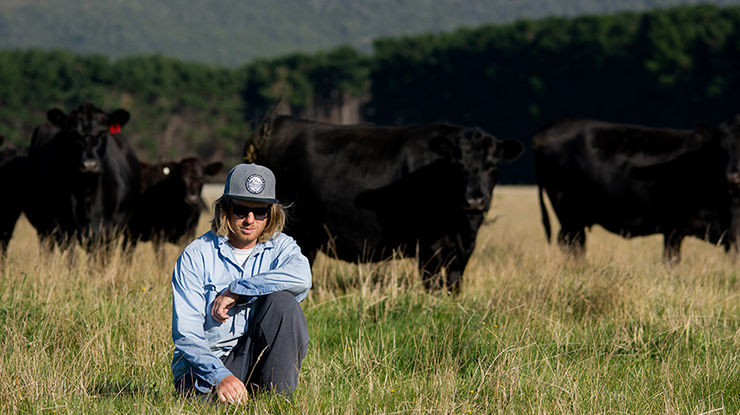 Caption: Tim with his Angus cattle in one if his limed paddocks.
Caption: Tim with his Angus cattle in one if his limed paddocks.
Lime squeezes new life into perennial pastures
When it comes to improving his feedbase, Flinders Island beef producer Tim Campbell found topdressing old established pasture with lime not only changed its composition, but also increased its productivity.
Tim’s property is in the Lackrana district of the island, off the coast of Tasmania. He produces F1 Wagyu/Angus-cross calves off Angus breeders for mainland feedlots.
“The island has undergone some major changes since soldier settlement in the 1950s with grazing shifting away from sheep toward cattle, and with some producers consolidating into larger operations,” Tim said.
Soils vary across the island, with alkaline, acidic and neutral types – Tim’s property has all three.
His farm ranges from peat soils with shell fragments on the east, which measure a neutral pH(CaCl2) of 7.7, to sandy loams on the west, which measure an acidic pH(CaCl2) of 4.5 with high aluminium levels.
To counter this variation in soil types, Tim relies on a range of pastures to match growing conditions.
These include perennial ryegrass and Phalaris across most paddocks, with:
- strawberry clover in alkaline flats
- white clover in red sandy loams
- sub-clover in lighter banks.
Understanding constraints
In 2008, Tim purchased a neighbouring property. It had declining perennial pastures, dominated by Yorkshire fog and sorrel.
“Yorkshire fog would become detrimental to our perennial crops if we didn’t address it,” Tim said.
“The sorrel was particularly worrying as can cause death in livestock when eaten in large quantities.”
Tim’s research before buying the property revealed the 1960s soldier settlement had once had excellent clover, trefoil and ryegrass pastures. These pastures deteriorated after becoming neglected in the 1990s when commodity prices dropped.
After purchasing the property, Tim treated the pastures with superphosphate. While this increased clover content, it failed to encourage clover to nodulate.
A soil test in January 2017 showed the paddock had a pH(CaCl2) of 4.76, which indicated acidic soils were likely to blame.
Taking action
Tim decided it was time to address all paddocks impacted by high acid soils, and joined the Southern Farming Systems (SFS) Flinders Island Healthy Soils group.
SFS had previously several field days on Flinders Island, and in 2020 facilitated the first group learning project on the island.
“The group consisted of 20 producers and together, with the facilitators, we explored a range of locally significant soil constraints and opportunities,” Tim said.
“We learnt from each other’s findings and experiences with feedbase and soil management strategies.”
The project focused on:
- soil salinity
- soil acidity
- soil compaction
- fertiliser types
- soil nutrition
- carbon
- trace elements and their influence on animal health.
Seeing results
In autumn, Tim applied 5t/ha of lime mixed with sand sourced from the local lime quarry, as a top dressing to his pastures in acidic soils.
A follow-up soil test in September showed pH(CaCl2) levels improved to 5.02 – a 0.26 increase within a year.
We saw a dramatic turnaround with an increase in clover nodulation. This resulted in more vigorous perennial ryegrass as the clover’s microbial population boosted pasture nitrogen levels,” Tim said.
“In the three years since introducing liming, our pastures have become more productive and are offering higher nutritional value for our cattle.
“We’re seeing them take off sooner after our autumn liming cycle and remain more productive over winter, reducing our need to supplementary feed.”
Now, Tim implements annual soil testing and visual assessment annually, and limes as required.



